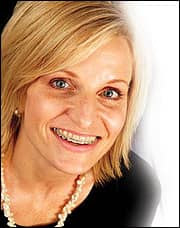by Betty Zuelke
How to get more grown-up patients into treatment

Do adults call to schedule an orthodontic exam for themselves, saying, “I would like to come for an orthodontic evaluation but I don’t want braces”? Have you seen adult new patients who say, “I am only here to see what my options are—I am just gathering information”? Do half of your adult patients leave the office after their initial exam—and never return?
I believe that everyone, including the adult patient, deserves the opportunity to have a gorgeous smile, and our job in the orthodontic profession is to help them find a way to have one. After 34 years in the profession, with a significant portion of that time specializing in enhancing case acceptance and TC training, it is obvious to me that case-acceptance rates would be dramatically higher and our undecided/pending files a great deal smaller if the profession focused exclusively on teenagers. Unfortunately, our practices would be a good deal less profitable as well!
During my years as a TC, I often said to my skeptical or uncertain adult patients, “It is never too late to have the beautiful smile of your dreams.” Today, with more and more adults seeking orthodontic care, the invention of Invisalign™, and much improved lingual bracket systems, it is easier
than ever for adults to have the beautiful smile they have always wanted. There also seems to be a greater focus on improvement in personal appearance (see Extreme Makeover, for example) today, driving even more adult inquiries about orthodontics. That is especially true considering that most healthy adults today can reasonably expect a life span upward of 90.
The Need for Speed
I have been working professionally in client offices for the past 16 years, and while I give my clients an overall case-acceptance goal of 75% (80% is optimum), an achievable target for adult case acceptance is 65%. I see practices with adult case acceptance ranging from a low of 15% to a high of 80%, but it is common for many practices to complain that they cannot get more than 50% of their adult new patients into treatment.

The key to improving results with adult new patients is to discover what it is that they want and then go about giving that to them. Sounds simple, doesn’t it? I did not say to let the adult patient dictate to you what your treatment plan should be. If, however, you do not pay attention to their desires, they will go to your competition—or worse yet, to their general dentist—to have their orthodontic need taken care of.
The simple fact is that most adults would love to have the smile of a magazine model—as quickly, as easily, and as inexpensively as possible. They have a desire and a need, and you have the product and the technology to fulfill their desire. You will have the best results when you give them what they want, and while they want a great smile, they also want a good deal more.
You must recognize that the more time between the new patient call and a new patient’s appliance placement, the easier it is for the adult patient to decline treatment. Adults must be on the fast track so buyer’s remorse does not set in. You must structure your schedule to accommodate the taking of all required records at the initial exam appointment. Equally important is that you must be able to diagnose the case and present a basic treatment plan at the exam without the need for a return (secondary) consultation. The TC must also be able to quote a specific treatment fee and make a financial arrangement at the first appointment. She must be positive and enthusiastic in her discussion of treatment and finances so the adult patient believes that orthodontics will be easy for him or her.
Let’s face it: You deal with complex clinical problems every day. You are the experts, and I have seen very few cases that are too hard to fix. Don’t make treatment seem too complicated or too expensive, or your patients will back out, go home, and commonly do nothing.
The TC’s Role
The TC is often the one who has to convince adult patients that it is OK to do something for themselves. Parents commonly sacrifice for their family and (especially moms) put themselves last. Many adults believe they are being vain if they commit to a cosmetic correction that is not “medically necessary.” It is the job of a TC to help adult patients feel good about their desire for a beautiful smile and to feel confident that their decision is not only the right decision for their long-term health, but that they do have a valid need and they are not just making a frivolous expenditure.
During the initial interview between the TC and adult new patients, the TC must first recognize that her role is to discover each patient’s unique needs and considerations which, if not addressed, will be a barrier to the acceptance of treatment. The TC must not only create a strong relationship, she must discover what adult patients are thinking and feeling about how their teeth look, their worries about discomfort, their concerns about treatment timing, if they will agree to cemented brackets, and their overall expectation of the end result. She must look for ways to give patients what they want as well as what they need clinically. Adult patients must feel welcomed and part of an extraordinary office that will transform their smile.
The TC must then be able to communicate each adult patient’s unique concerns and desires to you. She must also inform you of the type or method of treatment the adult patient will accept. I am not referring to co-diagnosing the case, although I am suggesting that the TC tell you if each adult patient is emotionally prepared to wear silver brackets or if the only treatment plan he or she will listen to is one with removable aligners.
The Clinical Exam
The best adult case acceptance is achieved when your part of the clinical exam is orchestrated in a consistent, concise discussion. If the discussion is one that hops from topic to topic and you appear uncertain or indecisive, case acceptance will be compromised. After the clinical measurements are taken, the discussion of treatment must include the following five key points:
- The orthodontic problem;
- the correction (be clear and specific—do not present treatment options);
- the benefits of treatment for this patient;
- the importance of beginning now; and
- the consequences of not correcting this orthodontic problem.
Adult new patients must clearly understand what they should worry about if their teeth never get fixed. They must thoroughly understand why they should spend upward of $6,000 on orthodontic correction, especially when cosmetics may not be a concern. They must also understand how their bite or malocclusion can worsen and cause ill effects that they could easily prevent by doing treatment now. Essentially, you and your TC need to help the adult patient want treatment badly enough that all other obstacles simply evaporate!
You should be careful not to give indecisive statements that will unsell the case, such as, “I will leave it up to you (the adult patient) to decide if you want braces,” or “You could have braces or aligners, it’s up to you; it really will not make any difference,” or “Nobody ever died of crooked teeth. You have lived this long without braces. …” Instead, help the adult patient make a decision now! Guide the patient to choose what you would do for your own spouse or sibling. Do not let the patient go home undecided.
Also, be careful not to use words that minimize the need for treatment and the cost. Words such as “minor,” “simple,” “easy,” and “a little bit of crowding” are inappropriate because your patient will not be charged a “minor” fee. If the problem is only “a little bit” bad, then patients might think that they don’t need to waste their time, effort, and expense.
Exploring Treatment Options
While it is important not to confuse adult patients with multiple methods of treatment and cause them to go for a second opinion to get a tiebreaker answer, there are some instances in which you need to explore treatment options to learn what will be the most suitable for your patient and/or involve the patient in the decision-making process (with your guidance). The important factor here is to guide the patient and rule out multiple choices so that the patient is left with one clear path. If this is a surgical case and you have clearly heard (perhaps from your TC) that surgery is not in the cards for this patient, then look for an alternative course of treatment. The finished result may not be something that qualifies for an ABO presentation, but the patient will be thrilled with the wonderful improvement and will be happy to have chosen you as an orthodontist.
Closing the Deal
You must also perfect your closing. Prior to leaving the adult new patient exam, you should close by saying the following:
- “Are there any other treatment-related questions I can answer for you?”
- “You are ready to get started. I would like to take the impressions today.”
- “I will leave you with (TC’s name), and she will review the steps we need to get started.”
- “I promise we will take great care of you. I know you will be happy you decided to do this.”
- “I’ll look forward to seeing you in the back.”
Your goals are to provide extraordinary care during the initial telephone call and the entire new-patient process, to show a strong practice image, and to make the financial process as flexible as possible so that adult patients decide that your office is the best place to have treatment. They must “feel” they want braces/aligners and they want to get those braces/aligners with your practice. By creating this feeling, the TC eliminates the thought of a second opinion.
To set the stage so that adult new patients will leave their first visit “enrolled” and committed to your practice, records should be been taken and all paperwork (including a Financial Agreement, Informed Consent, and Appointment Policy) should be completed and signed. The start appointment should be scheduled no longer than 7 to 10 days out, the TC should offer the opportunity for the patient to make an initial payment if the patient chooses, and the case is sold.
Betty Zuelke is an orthodontic consultant specializing in case acceptance and marketing. She has recently co-authored the Marketing Cookbook: Quality Marketing for Quality Patients, available at zuelke.com.










